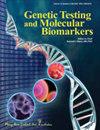德桑托-沙纳维综合征的表型谱:土耳其首例报告病例的比较报告
IF 1.1
4区 生物学
Q4 GENETICS & HEREDITY
引用次数: 0
摘要
德桑托-沙纳维综合征(DeSanto-Shinawi syndrome,DESSH,OMIM #616708)是一种由 WAC 基因致病变体引起的罕见遗传性疾病。该综合征的特征是广泛的躯体和神经症状,包括畸形特征、发育迟缓、智力障碍和行为异常。DESSH于2015年由DeSanto描述,自那时起,全球仅有几十例报道。近期的研究主要集中在确定该综合征的潜在遗传原因以及探索潜在的治疗方法。在本报告中,我们描述了一名女性病例,她具有畸形特征,包括睑裂过长、鼻根凹陷、鼻尖轻度凸出、上唇过薄、多毛、手指短,以及智力障碍、语言发育迟缓和运动迟缓。此外,她还伴有激动、焦虑和注意缺陷多动障碍(ADHD)等行为异常。临床外显子组测序显示,WAC基因第13外显子c.1837C>T,p. (Arg613Ter)存在致病性杂合子无义变异,且为从头遗传。据我们所知,这是土耳其报告的首例 DESSH 病例。我们的目的是报告这种罕见的综合征,并将我们病例的临床结果与之前文献中报告的病例进行比较。本文章由计算机程序翻译,如有差异,请以英文原文为准。
The Phenotypic Spectrum of Desanto-Shinawi Syndrome: A Comparative Report of the First Reported Case in Turkey.
DeSanto-Shinawi syndrome (DESSH, OMIM #616708) is a rare genetic disorder caused by pathogenic variants in the WAC gene. This syndrome is characterized by a wide range of physical and neurological symptoms including dysmorphic features, developmental delay, intellectual disability, and behavioral abnormalities. DESSH was described by DeSanto in 2015, and since then, only a few dozen cases have been reported worldwide. Recent research has focused on identifying the underlying genetic cause of the syndrome as well as exploring potential treatments. In this report, we describe a female case who had dysmorphic features including long palpebral fissures, depressed nasal root, mild bulbous nasal tip, thin upper lip, hypertrichosis, short fingers, and intellectual disability, speech delay, and motor retardation. In addition, she had behavioral abnormalities such as agitation, anxiety, and attention deficit hyperactivity disorder (ADHD). Clinical exome sequencing showed a pathogenic heterozygous nonsense variant in exon 13 of the WAC gene c.1837C>T, p.(Arg613Ter) with de novo inheritance. To the best of our knowledge, this is the first case of DESSH reported from Turkey. We aimed to report this rare syndrome and compare the clinical findings of our case with previously reported cases in the literature.
求助全文
通过发布文献求助,成功后即可免费获取论文全文。
去求助
来源期刊
CiteScore
2.50
自引率
7.10%
发文量
63
审稿时长
1 months
期刊介绍:
Genetic Testing and Molecular Biomarkers is the leading peer-reviewed journal covering all aspects of human genetic testing including molecular biomarkers. The Journal provides a forum for the development of new technology; the application of testing to decision making in an increasingly varied set of clinical situations; ethical, legal, social, and economic aspects of genetic testing; and issues concerning effective genetic counseling. This is the definitive resource for researchers, clinicians, and scientists who develop, perform, and interpret genetic tests and their results.
Genetic Testing and Molecular Biomarkers coverage includes:
-Diagnosis across the life span-
Risk assessment-
Carrier detection in individuals, couples, and populations-
Novel methods and new instrumentation for genetic testing-
Results of molecular, biochemical, and cytogenetic testing-
Genetic counseling

 求助内容:
求助内容: 应助结果提醒方式:
应助结果提醒方式:


